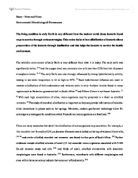A Pathophysiology Review on Emphysema
Abstract:
Emphysema is a chronic obstructive pulmonary disease (COPD) that permanently effects the way in which one lives. The pathophysiology of emphysema involve the enlargement of airspaces within the alveoli, along with a destroyed alveoli wall. There is no cure for emphysema but there are treatable methods to help make the symptoms much more easier on the patient. This involves making sure that as much gas as possible is exhaled out of the lungs. Smoking seems to be a major causal factor of emphysema, with research showing that a majority of COPD cases are because of cigarette smoking. Saying this, it does not mean that a non-smoker would not be able to be diagnosed with emphysema and this is due tot he deficiency of the enzyme alpha1 - antitryspin which is something that us found to be inherited thus making it genetic.
Introduction:
Emphysema is a chronic obstructive pulmonary disease (COPD) which occurs in the lungs, when an individual is affected by emphysema their air sacs are found to be larger than normal and this is due to the fact that the alveoli in the lungs have been permanently destroyed. As the disease progresses further the alveoli proceeds to have an unusual shape due to the continued enlargement of the air sacs, because of this, during exhalation there is great difficulty in airflow since the alveolar walls have been damaged making it difficult to breathe out. Furthermore the elastic connective tissue which helps support the alveoli in place also contributes to the difficulty in breathing since it has been destroyed (Handford et al., 2004). The clinical features of emphysema involve the deterioration of the alveoli which include the alveolar walls losing its structure (Chakir et al., 2008). A smoker is more likely to contract emphysema than a non smoker, however being diagnosed with emphysema does not only have to come from smoking, even non-smokers are able to contract emphysema (Becker et al, 2009) this happens when there is an genetic inherited deficiency of the enzyme alpha1 – antitrypsin (Braun and Anderson, 2007). Also other studies have shown that in the cases of early to mild emphysema, the obstruction of the airways can be caused by the inflammation of the lungs.
Smoking and Their Effects on Emphysema:
Researchers have looked into the effects of smoking and emphysema, this is due to the fact that smoking plays a contributing role into the destruction of the lungs due to the chemicals inside a cigarette such as nicotine and carbon monoxide. Smoking is something that can worsen the effects of emphysema by making it more difficult to breathe since the alpha1 – antitrypsin is prevented from functioning properly thus causing the phagocytes to release an extra amount of elastase than is needed (Handford et al., 2004). Although in 2007 Bailey and Dransfield et al. did not find any correlation between the amount of cigarettes smoked and the severity of emphysema. However a study in Japan done by Wang et al. did find a correlation between cigarette smoking and the severity of emphysema as did Gilloly and Lamb. The variations in results may have been due to the differences in the participants that was used in the study and also since both studies took place in different countries, so one could seem there would be a different environmental setting (Bailey et al.'s study took place in the United States of America). Although that, this would counter act what Becker et al. Found in 2009 where they stated that smoking cigarettes increases the chance of having emphysema, with 80-90% cases of COPD are because of cigarette smoking in the United States of America (Becker et al., 2009). Braun and Anderson also mention specifically ways in which the cigarettes smoke abrupt the alveoli, such as the toxic chemicals from the cigarette smoke causing the inflammatory response to be triggered. Upon this, the white blood cells neutrophils and macrophages are released into the lung. The elasticity of the lung has now weakened due to the neutrophils and macrophages releasing enzymes that harm the lung. This cases the alveoli to recoil and there is great difficulty releasing CO2 during expiration (Braun and Anderson, 2007). Furthermore the age of the participants used in the study were not stated so this may also be a factor into why both results turned out to be different since emphysema is likely to be more severe in the elderly than younger individuals since the elastic tissue in the lungs are more worn out. All these findings (except for Bailey and Dransfield et al.) seem to be favourable since it was reported by the journal website Medscape in 2011 that the majority of all COPD cases is due to harmful chemicals which can be found in cigarettes. In addition those who smoke and diagnosed with a sever and life threatening form of emphysema were found to have a lower activity of anti – elastase. This would cause an increasing amount of elastic tissue present in the lungs to wear down and thus becoming less elastic and able to function properly (Eden, E., 1999). Also Bailey et al. in 2007 compared genders (who smoked) and their severances of emphysema. He found out males had a more severe case of emphysema than females, this result was also found with Wang et al. in Japan who did the same study. It was suggested that this could give proof for differences in the pathophysiology of emphysema for both sexes.







